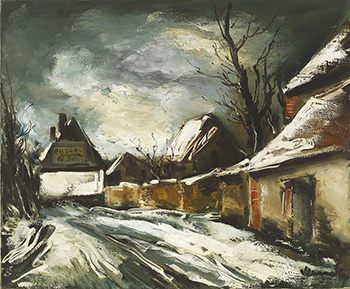PROVENANCE:
Ader-Tajan, Paris, December 16, 1991, lot 39 Private collection, Asia
This painting is to be sold with a certificate of authenticity signed by the expert on Vlaminck, Gilbert Petrides in 1991.
Catalogue Note:
VILLAGE SOUS LA NEIGE
MAURICE DE VLAMINCK
Village sous la Neige describe the scenery of french country village in snowy winter, is one of the master pieces of Vlaminck. As one of the founders in Fauvism, he once declared, I loved Van Gogh better than my own father! He worked in a style characterized by bold color and lively brushwork. The delicate texture in his exuberant stroke is mostly the reason why his painting is so incredible. The openness view was demonstrated from the works of early Fauvism with dispersed cottages in the wheat field to his late landscapes in the snow. Following his lead, viewers could even experience the frozen wind of snowfield as standing in Tolstoy's novel.
In this painting, the sun was obscured by clouds and impossible to emanate light and warmth. The sky was so intimidating that the animals restlessly surged for shelters. Our sight followed with the motion of a vehicle in the road to a gloomy corner far away. The snowy passage was tinted black by mud; the dreary branches and chimneys silently unfolded their torso to the sky. People sat aside to the fireplace rubbing their frozen hands while the artist wandered freely in this wild winter.
In retrospect, Vlaminck had depicted various snowscape scenery in different stages during his various artistic phrases, which reflects the artist's consistent endeavor in this genre and associated subject matter. It is apparent that Vlaminck had consistently explored the realms of scenery landscape, whereby many of these works are manifestations of his reality or inner emotions in responses to his artistic indulgence during the various phrases of his artistic development at a particular point in time.
Vlaminck, one of the original founders of Fauvism, was born in 1876 in Paris. Vlaminck was from a family of musicians thus he was naturally proficient with violin at young age. He also received basic training in painting between 1888 and 1891. Vlaminck has always been a revolutionary, from his involvement in Fauvism in the early 20th century to his passion for Expressionism in his later years. By 1908, Vlaminck's compositions became more orderly and the use of colors became more subdued due to the influence of Cubism. In 1954, he was invited to participate in the Venice biennial exhibition and in 1955, he was voted in as a member of L'Académie Royale in Belgium. The following year, Galerie Charpentier in Paris held a retrospective for his 80th birthday.
Village sous la Neige represents a masterful consolidation of form that is both enticing and anchoring. It differs and contrasts with the artist’s Fauves canvases inspired largely by works of Von Gogh whom the artist remained a key proponent of up until the 1908, after which his palette become more monochromatic largely due to the influence and response to the works of Cézanne that he had observed at an exhibition, an encounter that constituted a significant phrase of transition in Vlaminck’s artistic development. This prolific phrase subsequently extended to a fruitful personal exhibition of larger scale in 1909. In Vlaminck’s latter artistic endeavors, the artist demonstrated difficulty in accepting Cubism’s rise during the war in Paris when artistic modernism was undergoing a delicate transition from Fauvism to Cubism in France. In essence, Vlaminck sought to progress beyond a style much like Henri Matisse and Andre Derain, all whilst retaining his idiosyncratic and instinctive manner of the application of paint.


